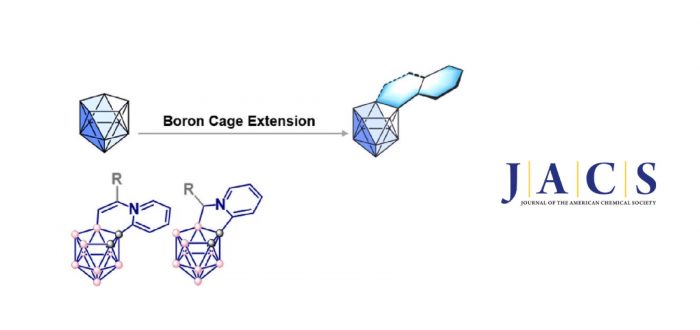Aromatic polycyclic systems have been extensively utilized as structural subunits for the preparation of various functional molecules. Currently, aromatics-based polycyclic systems are predominantly generated from the extension of two-dimensional (2D) aromatic rings. In contrast, polycyclic compounds based on the extension of three-dimensional (3D) aromatics such as boron clusters are less studied. Here, we report three types of boron cluster-cored tricyclic molecular systems, which are constructed from a 2D aromatic ring, a 3D aromatic nido-carborane, and an alkyne. These new tricyclic compounds can be facilely accessed by Pd-catalyzed B?H activation and the subseqüent cascade heteroannulation of carborane and pyridine with an alkyne in an isolated yield of up to 85% under mild conditions without any additives. Computational results indicate that the newly generated ring from the fusion of the 3D carborane, the 2D pyridyl ring, and an alkyne is nonaromatic. However, such fusion not only leads to a 1H chemical shift considerably downfield shifted owing to the strong diatropic ring current of the embedded carborane but also devotes to new improved physicochemical properties including increased thermal stability, the emergence of a new absorption band, and a largely red-shifted emission band and enhanced emission efficiency. Besides, a number of bright, color-tunable solid emitters spanning over all visible light are obtained with absolute luminescence efficiency of up to 61%, in contrast to aggregation-caused emission quenching of, e.g., Rhodamine B containing a 2D-aromatics-fused structure. This work demonstrates that the new hybrid conjugated tricyclic systems might be promising structural scaffolds for the construction of functional molecules.
This work has been carried out by F. Sun, S. Tan, H.-J. Cao, C.-S. Lu, Dr. D. Tu and Prof. Hong Yan* from Nanjing University, Prof. Jordi Poater from the University of Barcelona and Prof. Miquel Solà from the Institute of Computational Chemistry and Catalysis of the University of Girona. It has recently been published in the Journal of the American Chemical Society:
F. Sun, S. Tan, H. Cao, C. Lu, D. Tu, J. Poater, M. Solà and H. Yan
“Facile Construction of New Hybrid Conjugation via Boron Cage Extension”
J. Am. Chem. Soc. 2023, [], ASAP-
DOI: 10.1021/jacs.2c12526
Girona, Feb. 15, 2023
For more info: gestor.iqcc@gmail.com

